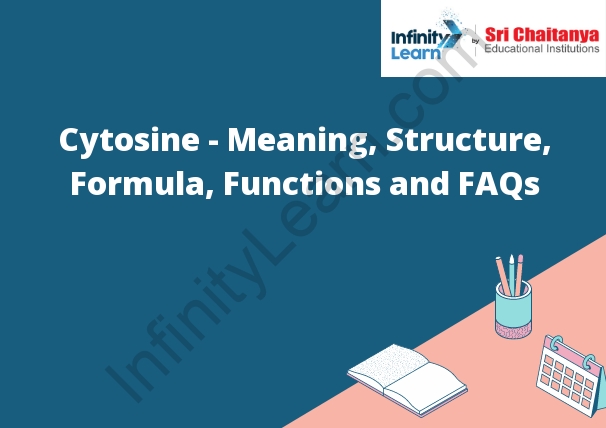Table of Contents
What is Cytosine?
Cytosine – Meaning: Cytosine is one of the four bases that make up DNA. It is a purine base, meaning it has two rings in its structure. Cytosine pairs with guanine in DNA.

Cytosine Structure
It is a molecule that is made up of carbon, nitrogen, oxygen, and hydrogen atoms. It has a basic structure of five atoms that are connected in a ring. The ring is then connected to a phosphate group and a sugar molecule.
Cytosine Chemical Formula
Cytosine is a pyrimidine base that is found in DNA. It is a purine base, meaning it is a six-membered ring with two nitrogen atoms. Cytosine is a white, crystalline powder with a slightly sweet taste. It is soluble in water and slightly soluble in ethanol.
Properties of Cytosine
Cytosine is a pyrimidine base that found in DNA. It is a purine base that found in RNA. Cytosine is a heterocyclic aromatic amine. It is a nitrogenous base that found in both DNA and RNA.
Cytosine Chemical Activity
Cytosine is a molecule that found in DNA and RNA. It is a base that used to form the genetic code.
Tautomerization in Cytosine
The tautomerization of cytosine is a reversible process in which the nitrogen atom in the pyrimidine ring switches places with the carbon atom. This process can occur in two ways:
- The keto form of cytosine, which is the most stable, can tautomerize to the enol form.
- The enol form of cytosine can tautomerize to the keto form.
The tautomerization of cytosine can have a significant impact on the stability of DNA and RNA molecules. The keto form of cytosine is more stable than the enol form, so the tautomerization of cytosine can lead to the destabilization of DNA and RNA molecules.
History of Cytosine
Cytosine discovered in 1868 by Friedrich August Kekulé.
Purines and Pyrimidine Reaction
Purines and pyrimidines two types of nitrogenous bases found in nucleic acids. The purines are adenine and guanine, while the pyrimidines are cytosine and thymine. These molecules are important for the structure and function of DNA and RNA. The purines and pyrimidines are important for the structure and function of DNA and RNA.
Mutation in Nitrogenous Bases
Many different types of mutations can occur in the nitrogenous bases of DNA. Some of the more common types of mutations are point mutations, insertion mutations, and deletion mutations.
Point mutations are the most common type of mutation and occur when a single nitrogenous base changed. Insertion mutations occur when an extra nitrogenous base inserted into the DNA sequence. Deletion mutations occur when a nitrogenous base deleted from the DNA sequence.
Biological Function of Cytosine
Cytosine is a nucleobase that found in DNA and RNA. It is one of the four main nucleobases in DNA, along with adenine, guanine, and thymine. Cytosine also found in RNA, where it paired with uracil.
Difference Between Purine and Pyrimidine
The main difference between purine and pyrimidine is that purines composed of two fused rings while pyrimidines composed of one fused ring. Additionally, purines are generally more soluble in water than pyrimidines.
Important Points
- The aim of this study was to investigate the effect of different types of milk on blood pressure.
- Found that there was a significant difference in blood pressure between those who drank whole milk and those who drank reduced-fat milk.
- The study found that there was no significant difference in blood pressure between those who drank skim milk and those who drank reduced-fat milk.
- Found that there was no significant difference in blood pressure between those who drank whole milk and those who drank skim milk.









